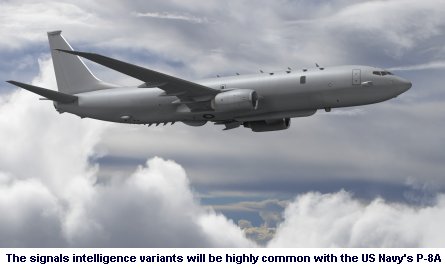Twinjet will face stiff opposition, however, as smaller aircraft will be evaluated for role
Boeing plans to offer the 737 airliner for a next-generation signals intelligence (SIGINT) requirement that could arise following the setback to the US Army/Navy Aerial Common Sensor (ACS) programme. The services are leading a six-month study also involving the US Air Force and senior defence officials, which seeks to lay the framework for a strategy to replace the army’s de Havilland Canada RC-7 Aerial Reconnaissance Low and Beech RC-12 Guardrail SIGINT aircraft fleets and the navy’s Lockheed Martin EP-3E Aries IIs.

The modernisation is now planned for 2014-17, shortly after the USN’s first of 108 737-based Boeing P-8A Multi-mission Maritime Aircraft (MMA) enters service in 2013, replacing its Lockheed P-3C Orions. “This [timeframe] really sets up very nicely,” says Tim Norgart, Boeing’s MMA programme manager.
The 737 SIGINT aircraft would be modelled closely on the design of the P-8A, which combines the 737-800’s airframe with the wing of the 737-900, and would share common avionics and engines. Boeing has revealed a notional SIGINT layout that would include 14 workstations, rather than the P-8A’s five operator consoles. The layout is most similar to the current cabin design of the EP-3 and offers far more capacity than the abandoned ACS layout, which included six workstations.
It is unclear whether the 737 is compatible with the army’s current operational profile for the airborne SIGINT mission. The service likes to use multi-ship packages of small aircraft operating at high altitude, with most processing work completed off-board. Norgart acknowledges that Boeing “has not had a good look at the [army’s concept of operations]” for ACS, but says: “We can operate across the entire flight profile.”
Edward Bair, the army’s programme executive officer for intelligence, electronic warfare and sensors, has previously said that the 737 would be among the candidates scrutinised during the six-month study phase.
But the army and navy also plan to look at the option of buying a smaller aircraft augmented by connections to sensors aboard unmanned air vehicles.
USAF involvement in the current study phase also suggests there may be the potential for the longer-term replacement of its Boeing 707-based RC-135 Rivet Joint intelligence-gatherer aircraft.
STEPHEN TRIMBLE / WASHINGTON DC
Source: Flight International
















